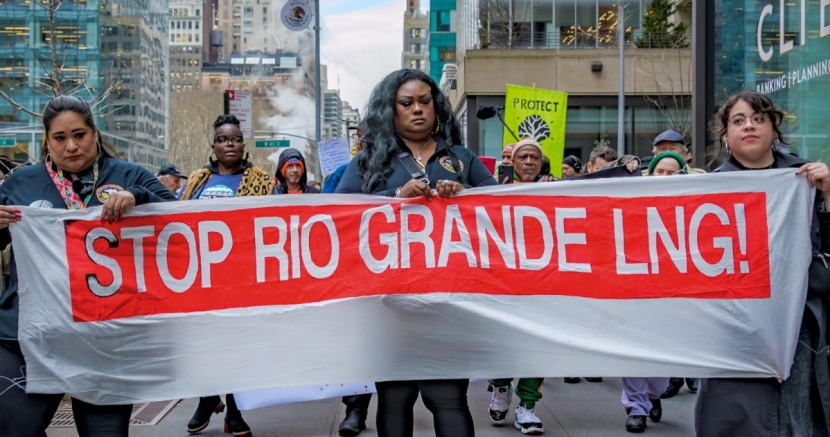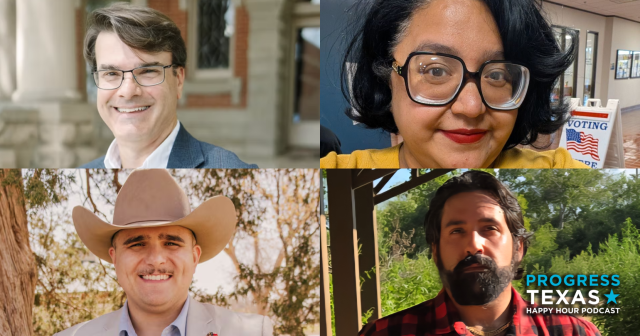LNG Industrialization: What it means for the RGV

Originally published on 1, May, 2024
Link to original story from Trucha at TruchaRGV.com: https://truchargv.com/lng-industrialization-what-it-means-for-the-rgv/
“Trucha is a grassroots multimedia nonprofit organization that aims to uplift the stories, culture, and social movements of migrant and queer communities in the Rio Grande Valley through community journalism, videography, and cultural programming.”
It’s been almost 10 years since plans were proposed to construct Liquefied Natural Gas (LNG) export terminals in the Port of Brownsville. What followed has been a tumultuous journey of environmental impact reviews, loss of funding, controversies, and protests from countless community members and organizations denouncing the proposals. Thanks mainly to resistance from Indigenous groups and environmental advocates in the RGV, three LNG export terminal projects have been suspended, the most recent happening in March 2021.
However, two major projects are still proposed for the Port of Brownsville: Rio Grande LNG and Texas LNG. In July of last year, Rio Grande LNG announced that it had secured $5 billion in financing; however, this remains years from completion. In January, the Biden administration announced a pause on LNG export approvals; however, this does not affect the facilities already approved at the Port of Brownsville.
Despite this, the Carrizo Comecrudo Tribe of Texas and environmental activists, such as the South Texas Environmental Justice Network (STEJN), continue campaigning against the LNG terminals, hoping to thwart the irreversible ecological impacts they will have on our communities.
“The whole thing is very destructive. It’s very polluting,” said Dr. Christopher Basaldú, member of the Carrizo Comecrudo Tribe and a founding member of STEJN. “There are a lot of ancient village sites out in the area that are just being destroyed or bulldozed.”
Dr. Basaldu speaking out against a land exchange between the Texas Parks & Wildlife Commission and SpaceX. The land exchange would give away more of Boca Chica Beach to the tech giant. Photo courtesy of South Texas Environmental Justice Network’s Facebook page.
What Exactly is an LNG Export Terminal?
Natural gas is obtained from fracking, turned into a liquid form, and stored in specialized containers. This liquid is shipped to destinations worldwide, reheated to return to its gas form, and then transported to distribution companies. If constructed, Rio Grande LNG will be one of the largest facilities in the country and a major global exporter, particularly to Europe and Asia.
“These two facilities for Brownsville, the fracked gas export terminals, 100 percent of that gas is for export; none of it’s for local consumption,” said Dr. Basaldú.
The Port of Brownsville is an area of interest to natural gas companies due to its location on the Gulf of Mexico, which makes transportation easier. The area is the last major location along the Gulf that remains untouched and free of the fossil fuel industry.
Who is trying to bring it to the RGV?
The ones responsible for the construction of these terminals are both Houston-based companies. NextDecade owns Rio Grande LNG, and Glenfarne Group owns Texas LNG.
The companies have experienced difficulties establishing these projects, struggling to secure funding just last year, and have been involved in controversies. NextDecade reportedly wrote ghost letters for RGV officials, expressing support for the Rio Grande LNG, had the RGV officials sign them with minimal to no edits, and sent them to the Federal Energy Regulatory Commission.
Some of the delays and financial difficulties these companies have experienced are due to the tireless work of local activists. Members of the Carrizo Comecrudo Tribe, such as Tribal Chairman Juan B. Mancias, Dr. Basaldú, and prominent environmental organizer Bekah Hinojosa, have traveled to Europe to persuade banks and other financial backers to withdraw their support. Mancias and Hinojosa secured the international bank BNP Paribas’s withdrawal from Texas LNG in 2017 and the bank Societe Generale’s withdraw from Rio Grande LNG in 2023.
“Even bank executives that make decisions on where literally millions upon billions of dollars go to fund these projects, they don’t care about the environmental impact,” said Dr. Basaldú. “They only care about making money.”
Members of the Carrizo Comecrudo Tribe of Texas, including Dr. Basaldú and tribal leader Juan Mancias, along with other environmental activists, protesting LNG terminals in Port Isabel. Photo courtesy of South Texas Environmental Justice Network’s Facebook page.
Do the LNG projects have support?
Several politicians have expressed support for the construction of the terminals. In previous years, through press releases, Sen. Ted Cruz has expressed his approval for the project, stating, “These projects will further economic growth, help employ thousands of hardworking men and women, lower energy costs, and increase America’s energy independence.”
Rep. Henry Cuellar has sponsored legislation advancing LNG export plans and speaks about the benefits of LNG exports.
The support for these projects once again highlights elected officials’ refusal to listen to the concerns of the Carrizo Comecrudo Tribe and community members.
“Our elected officials that green light these projects here in the local community, they themselves don’t know the history of the land. They don’t want to learn. They ignore us,” said Dr. Basaldú.
What impacts will the LNG projects have?
“I’m not blaming our community down here for not knowing, you know, our media is complicit in being a booster for the militarization and dehumanization of people of color and poor people and queer people, and disabled people,” said Dr. Basaldú.
According to a report, here are some of the major impacts of these projects:
- Destroying sacred Indigenous land: Texas LNG was proposed to be constructed on a burial site of the Carrizo Comecrudo Tribe. The site is currently listed as endangered by the World Monuments Fund.
- Damage to our ecosystem: Construction of these projects will destroy habitats for endangered species such as the Ocelot. The wetlands and part of the wildlife corridor will need to be paved over once construction begins, severely impacting wildlife in the area.
- Irreversible Pollution: The terminals will release an immense amount of greenhouse gases that are terrible for climate change. According to the report, it will be as much as 40.4 million cars yearly!
- Health impacts: LNG terminals emit harmful pollutants into the air that can increase the chances of respiratory disease, heart disease, and cancer. This puts community members’ health at risk. Rio Grande LNG and Texas LNG would be the largest single-source polluters in the Valley.
Show Up on June 4
On June 4th, at their regular meeting, the Cameron County Commissioners Court will vote on approving tax abatement/tax break agreements with both Texas LNG and Rio Grande LNG. As Cameron County raises property taxes for the general public, the multimillion-dollar gas industry is asking Cameron County to give them tax breaks. The gas industry will use our public resources like roads and water without paying their fair share to maintain or fix Cameron County infrastructure, just so they can grab higher profits.
If community members want to voice their opinions about this issue, they can do so in person at the June 4 meeting, which begins at 9:30 a.m. at 1100 E. Monroe Street in Brownsville.
DONATE
Your donation supports our media and helps us keep it free of ads and paywalls.








